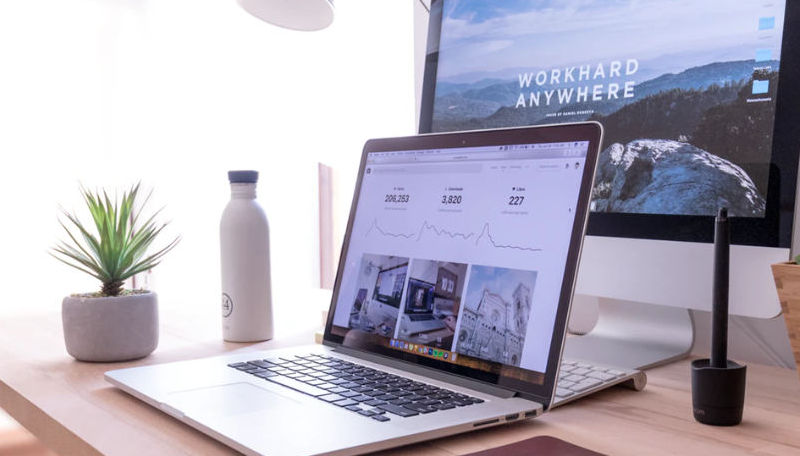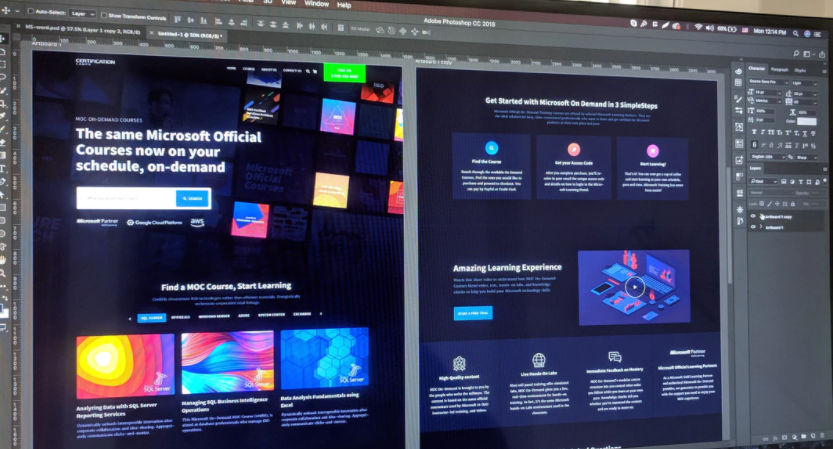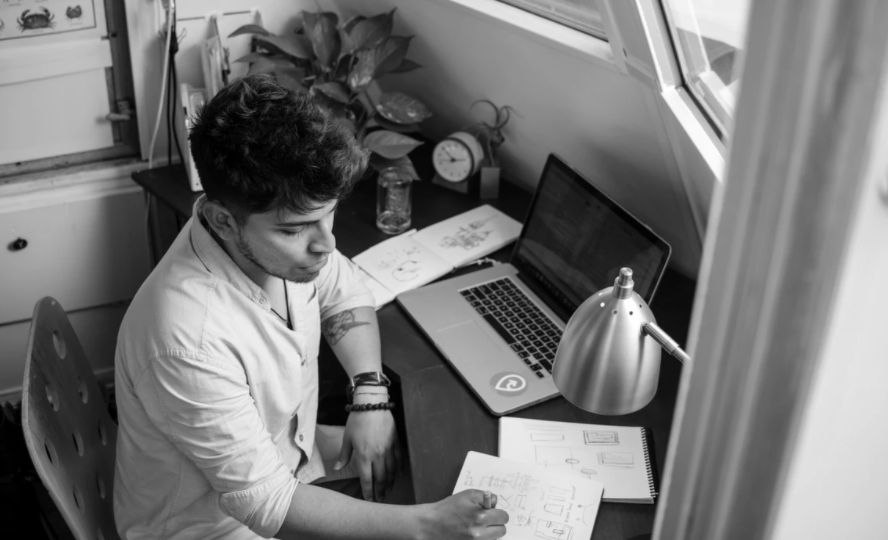

Web Site Design is the process of creating web pages of a given theme or style in order to convey a message to the visiting reader. Web design has come a long
way over the last 20 years, from the early days of using microsoft page writing software such as Frontpage, through to state of the art graphics design packages and
web site creation and maintenance tools such as offerings from Adobe, Wordpress and its components and many more.
In today's increasingly digital world, website design plays a critical role in shaping the user experience and ensuring that websites achieve their goals. As a website designer, it is important to stay informed about the latest trends, best practices, and design principles in order to create functional, visually appealing, and user-friendly websites.
This comprehensive guide will discuss all aspects of website design, from understanding the basics to implementing advanced techniques. Along the way, we'll cover essential topics such as color theory, typography, accessibility, responsive design, and search engine optimization (SEO).
Understanding the Basics of Website Design
1.1. The Role of a Website Designer
A website designer is responsible for creating the visual layout, interface, and overall look and feel of a website. Their primary tasks include selecting the color palette, typography, imagery, and other design elements to create a cohesive and visually appealing user experience. They must also work closely with developers to ensure that the design is translated effectively into a functional website.
1.2. Website Design Principles
To create a successful website, designers must follow certain design principles, such as:
Balance: Ensuring that the layout, colors, and elements are well-balanced and evenly distributed across the page
Contrast: Using contrasting colors, shapes, and sizes to make important elements stand out
Consistency: Maintaining a consistent look and feel across all pages of the website
Unity: Creating a cohesive design by tying together all elements and pages
Color Theory and Typography in Website Design
2.1. Color Theory
Colors play a vital role in web design, as they can evoke emotions, convey messages, and create a specific atmosphere. To choose the right color palette, consider the following:
Brand identity: Align your color choices with your brand's personality and values
Color psychology: Understand the associations and emotions that different colors can evoke
Accessibility: Ensure that your color choices are easily readable and accessible to all users
2.2. Typography
Typography is another essential aspect of web design, as it affects readability and the overall aesthetic of your site. Here are some key considerations:
Font selection: Choose a font that reflects your brand identity and is easy to read
Font size and hierarchy: Establish a clear hierarchy of font sizes and styles for headings, subheadings, and body text
Line spacing and alignment: Use appropriate line spacing and alignment to ensure readability and a polished appearance
Website Accessibility
3.1. The Importance of Accessibility
Accessibility is the practice of designing websites that are usable by people with various disabilities, such as visual impairments, hearing loss, or motor disabilities. By prioritizing accessibility, you ensure that your website is inclusive and compliant with relevant laws and guidelines.
3.2. Accessibility Best Practices
Some key accessibility best practices include:
Using proper HTML structure, including headings and landmarks
Providing alternative text for images and media
Ensuring sufficient color contrast for text and backgrounds
Implementing keyboard navigation and focus indicators
Responsive Design and Mobile-First Approach
4.1. Responsive Design
Responsive design is the practice of creating websites that adapt to different screen sizes and devices, ensuring a consistent and enjoyable user experience. To achieve this, designers must employ flexible layouts, images, and CSS media queries.
4.2. Mobile-First Approach
The mobile-first approach prioritizes the design and optimization of a website for mobile devices before desktop. This strategy reflects the growing importance of mobile browsing and ensures that your website performs well on a wide range of devices.
Search Engine Optimization (SEO) in Website Design
5.1. The Importance of SEO
SEO is a crucial aspect of website design, as it helps to improve your website's visibility on search engines, driving organic traffic, and increasing overall online presence. By implementing SEO best practices, you can ensure that your website ranks higher in search engine results pages (SERPs).
5.2. SEO Best Practices for Web Designers
Some key SEO best practices for web designers include:
Creating a clear site structure with a logical hierarchy and easily navigable menus
Using descriptive, keyword-rich headings, and meta tags
Implementing schema markup for structured data
Optimizing images and media for faster loading times and improved user experience
Ensuring a mobile-friendly, responsive design
The User Experience (UX) in Website Design
6.1. The Importance of UX
User experience (UX) refers to how users perceive and interact with your website. A good UX is essential for creating positive user engagement, increasing conversions, and establishing customer loyalty.
6.2. UX Best Practices
To enhance the user experience, consider the following best practices:
Minimize cognitive load: Make it easy for users to understand and navigate your website by using clear labels, concise content, and consistent design elements
Provide clear call-to-actions (CTAs): Guide users towards desired actions by using prominent and descriptive CTAs
Design for scanning: Structure your content in a way that allows users to quickly scan for information, using headings, bullet points, and white space
Prioritize page speed: Optimize your website's performance to reduce loading times and enhance the user experience
Emerging Trends in Website Design
7.1. Dark Mode
Dark mode is a popular design trend that offers users a choice between a light or dark color scheme. It can improve readability in low-light conditions and reduce eye strain, making it an attractive option for many users.
7.2. Minimalism and White Space
Minimalist design emphasizes simplicity and functionality, often using generous amounts of white space to create a clean and clutter-free look. This approach can help users focus on important content and navigate the website more easily.
7.3. Micro-Interactions
Micro-interactions are small, interactive elements that provide feedback or enhance the user experience, such as animations, hover effects, or progress indicators. They can make your website feel more engaging and intuitive, and create a memorable user experience.
Conclusion
Website design is a complex and ever-evolving field, with many factors to consider, such as color theory, typography, accessibility, responsive design, SEO, and emerging trends. As a website designer, it is essential to stay informed and continuously adapt your skills to create visually appealing, functional, and user-friendly websites that meet the needs of your clients and users. By following the best practices and principles outlined in this guide, you can ensure that your website design is both effective and up-to-date.

Our preference for almost all of the web designs we create for Manchester or Stockport based companies is to use raw PHP programming along with HTML, CSS, JavaScript and SQL if a database is required.
We prefer this because we are in a strong position moving forward, as we (and therefore our customers) do not rely on sketchy third party products and support.
Wordpress, for our company, is another no. We have very little faith in many plug ins and other add ons. Some of these are written by amateur programmers rather than experts or award winning web designers
and we feel it is not in the best interests for ongoing support and development to provide wordpress designs as a primary web solution for a content management system (CMS). It should be noted however,
that in the event a customer would actually like a blogging facility, we do install a copy of the wordpress blog software for free - alongside your main custom website - but
we will not provide support for it.
A huge part of the web design process is the creation of graphics for elements of the pages across the website. These form the site navigation (menu) and call to action facilities - such as email us or click here to buy now.
Additional graphics are photographs (especially for photographers) for creativity and larger area fill designs. These can be found on photo studio websites or design studios in general. They can be obtained either on a shared license basis or exclusive to give
your web design a unique look and feel to enhance the user experience.

With so many companies to choose from it can be difficult deciding where to go to get your web design work started. For small bespoke website ideas, such as five or ten pages
which contain information about your services and companies location, along with online reviews, you might be better off sourcing your design from a small but full time
freelancer. This can sometimes be more cost effective than using a large studio based web design agency.
For bespoke e-commerce projects or custom designs - depending on a number of factors a multi-skilled web agency might be more appropriate - but not always. Design and development of
a website can sometimes be done faster by a more flexible company or individual who is not bound by the limitations of many other ongoing programming projects.
Custom or Bespoke software solutions need designing by a company with a web design team willing to sit and perform business analysis - the scale of the project development and ongoing marketing
should play a role in determining who you hire to complete the coding and implementation.

Search Engine Optimisation
In an ideal world, your web design services company will also provide digital marketing services with a marketing strategy. These should at the very least include Search Engine Optimisation or SEO.
We have a separate section on our website which has a guide to SEO services in a lot of detail. Overall though, the developer should be able to incorporate the underlying code framework
to support any future work on the search engines. Some web designers do not always tie design and seo together.
Designing for Social Media
Once your website development is in place, then you will need the web designers to create social media pages with the branding to match their domain designing looks, especially for e-commerce. This is
to ensure that the brand is shown across multiple platforms meaning clients know who they are dealing with.
Your business website should be consistent with your social media designs. For example whether you are a Chimney Sweeper or an Electrician or Plumber your style should be the same at each presentation.

Business Information and Branding from a Design Company
A design can be creative and heavily branded but it has to perform a given task identified during the development process. It is not enough to have the very best Adobe graphics or the latest CSS tricks and
flashy icons if the site has not been thought through in terms of what it has to actually achieve. A website can be either a company business information source, for example a Daycare / Childcare site or a functional
part of the business process which could include administration, customer ordering with a shopping cart, contact facilities via phone or online forms.
Always ensure that the final website design will give you want you want, refer back to original concepts with the web design company if you need to along the way.

Your Brand
Web designers and providers of complete web design projects should always ask whether your business has a known brand identity such as many hair salons would, or whether you are looking to create one or make changes. It is important that the
final web design incorporates your brands identity prominently throughout the site. It may be that your company already has artwork and branding on marketing material
including the side of vans or posters and business cards.
Logo Design
We can provide logo design for your company which can be derived from existing graphics and artwork in PDF, JPG or Paintshop pro format along with SVG (scaleable vector graphics).
Alternatively, new logo designs can be produced for your digital strategy and a selection of variations can be presented from which one can be chosen.
All designs can be ported to printers and other logo branded merchandise providers for replication.

With everything from website design (and responsive web design) through to web hosting, email, search engines, cutting edge content marketing and social media marketing, graphic design and logos under one roof, you can't go wrong with Photon Flux Web Design. So for an informal chat about what you need, get in touch via a phone call or contact us using the form below